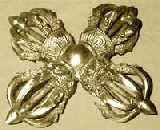| |
Buddhism was introduced into Tibet in the 7th century, during the reign of Tubo King Songtsan Gambo, and gradually infiltrated Tibet's history, politics, economics, culture, exchanges, and habits and customs to become the most extensively worshipped religion of Tibetans.
 |
|
Vajra
|
Tibetan Buddhism (Lamaism) has exerted extensive and profound influence on the Tibetan people. Prolonged ethnic cultural exchanges also enabled Tibetan Buddhism to make its way into the Mongolian and other ethnic minority nationalities throughout China. Buddhism has long been widely worshipped in Tibet, especially in the traditional Kham and Amdo areas. It has also made its way into Bhutan, Nepal, and Mongolia.
 Formation of Tibetan Buddhism Formation of Tibetan Buddhism
The spread of Buddhism to Tibet is attributed to Tibetan King Songtsan Gambo, who did his best to establish friendly ties with neighboring countries and learn from the cultures of other countries.
His marriage with Princess Khridzun of Nepal and Princess Wencheng of China's Tang Dynasty (618-907) facilitated the introduction of Buddhism to Tibet. Each princess journeyed to Tibet with statues of Buddha and Buddhism scriptures. Artisans accompanying the princesses participated in the construction of the Jokhang and Ramoche monasteries. Also, Buddhist monks from Nepal and China began translating Buddhist scriptures. Buddhism thus was spread in Tibet.
Tibet went though a power struggle for more than half a century after the death of Songtsan Gambo. Buddhism failed to flourish until Tride Zhotsan, Songtsan Gambo's great grandson who took power in 710. He married Princess Jincheng of the Tang Dynasty.
The new bride moved the statue of Buddha, which Princess Wencheng brought to Tibet, to the Jokhang Monastery. Meanwhile, she arranged monks accompanying her to the Tubo Kingdom (629-846) to take charge of the monastery and related religious activities. She engaged in a painstaking effort and finally succeeding in persuading the Tubo court to accept monks fleeing from western regions and build seven monasteries to house them.
While the measures further boosted the development of Buddhism in Tibet, they nonetheless sparked discontent among Bon-worshiping ministers. The ministers left no stone unturned to obstruct the development of Buddhism, with the situation lasting until Trisong Detsan, the son of Tride Zhotsan, came to power.
Trison Detsan relied on Buddhism to fight ministers who rallied behind the Bon religion. As part of the effort, he invited Zhibatsho and Padmasambhava, famous Indian monks, to build the Samye Monastery in 799. Seven noble children were later tonsured (shaved, signifying acceptance) to the monastery, which became the first monastery in Tibetan Buddhist history to tonsure monks.
In addition to inviting Indian monks to Tibet, Trisong Destan sent trusted emissaries to China's hinterland to invite monks to lecture in Tibet. Mahayana became one of the many Han monks who contributed to ensuring that Han Buddhism flourished in Tibet. Mahayana remained in Tibet for 11 years, lecturing on Buddhism and completing nine books on Buddhist tenets.
 |
|
Scull Cup
|
Tubo kings in ensuing dynasties did their utmost to promote Buddhism by building monasteries and commissioning the translation of Buddhist sutras. At the same time, they granted monks royal incomes and even encouraged them to become involved in government affairs to undermine ministers who supported the Bon religion. The policy spawned the deep hatred of the Bon ministers, who eventually arranged for the assassination of Tritso Detsan in 842. The ministers then threw their support behind Darma, the brother of Tritso Detsan, to become the new Tubo king.
Shortly after assuming power, Darma set out to suppress Buddhism, but was soon assassinated by Tibetan Buddhists, and war erupted between the different power factions. Slaves, who were thrown into the abyss of misery, rose to revolt. Tibet was torn apart by various forces, and the spread of Buddhism was thus halted.
|
|
